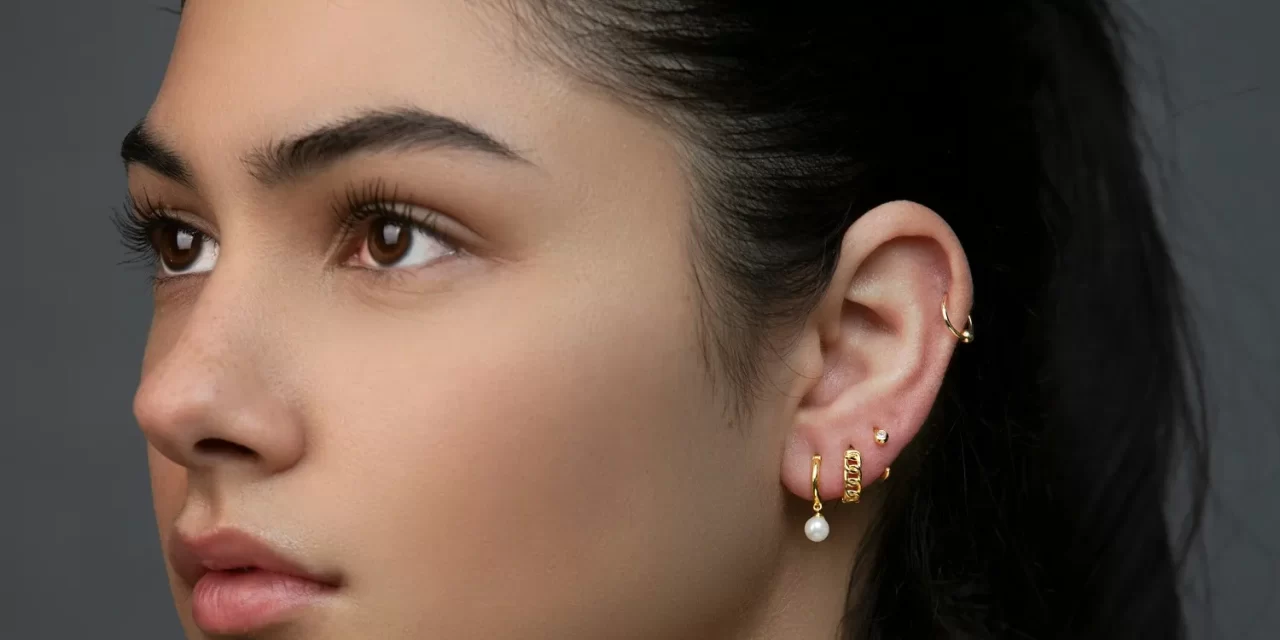Choosing the right type of ear piercing for yourself can sometimes be overwhelming. An ear piercing is not just some sparkly ornament you have in your ear, it’s also not a passing fancy. It’s a form of art that complements your facial structure and individual fashion sense.
However, choosing the right type, and placement option for ear piercing can take time and effort to make. On top of that, there’s also the pain level and aftercare to consider.
Below we explore various types of ear piercings based on pain and placement.
Helix
Helix is still the most popular ear piercing out there. The position of this pricing is anywhere on the upper outer rim of the ear. This piercing is so popular because of its versatility. You can do a helix piercing with many different earrings and design options.
Since the helix piercing is placed on the cartilage, the pain level is rated number 4 or 5/10 on the pain scale. So, it’s not very painful.
When it comes to healing time, it will vary from person to person but generally, it can last from 6 months up to a year. The initial healing time is some 2 to 4 months and then 6 to 12 months for the piercing to fully heal.
Additionally, you should use an antibacterial cleansing solution at least twice a day until the piercing heals completely.
Tragus
Yet another type of piercing that has gained a lot of popularity in recent years is tragus piercing. Tragus piercing is located on that tiny cartilage flap that covers the ear canal.
Because of its placement, the piercing is very eye-catching and unique.
Like most cartilage piercings, the tragus is rated around 5/10 on the pain scale. And also just like most cartilage piercings, it takes some 6 to 12 months to heal.
To ensure that your tragus piercing is healing properly, gently clean it with a sterile saline solution. And since moisture can lead to bacteria, make sure you properly dry it afterward. Also, avoid swimming for 2 to 3 weeks after getting the ear pierced.
Conch
You can find the conch piercing situated in the central portion of the ear cartilage. The name of this piercing comes from its resemblance to a spiral sea shell of the same name.
Conch is one of the most versatile and highly requested ear piercings. Once again, since this is a cartilage piercing, the general pain level will be around 5/10 on the pain scale. However, the pain level will vary from person to person.
Typically, the healing time will take from 3 to 6 months, and sometimes even longer. But to speed up the healing process, you can clean the piercing with a saline solution or a sea salt soak. Also, avoid swimming a couple of weeks after getting the piercing.
Daith
Unlike the conch piercing, daith is a hoop that is placed on the cartilage on the inside of the ear. The hoop hugs the cartilage and gives it a nice look. There are other types of jewelry used for daith but hoop is the most recommended because it’s very versatile.
The rating of daith on the pain scale is 5/10, but just like with every piercing, the pain will vary from person to person.
Daith takes 6 to 9 months to heal but once again, that’s relative. For it to heal well, you’ll need to clean and disinfect the area regularly with a sterile saline solution or piercing cleaner.
Orbital
If you want to achieve a bold and unique look, orbital piercings might just be the right option for you. To get an orbital piercing, the piercer will have to pierce two holes in your ear. The holes are usually near each other and connected by a single piece of jewelry. So, you’ll have two holes in the lobe or cartilage.
The pain level for this piercing is relatively low, around 4/10 on the pain scale. The healing time is also relatively short compared to other piercings – from 6 to 8 weeks typically. And just like with other piercings, use saline solution to gently clean the piercing at least twice a day.
Rook
Nestled in the upper ear cartilage, above the daith piercing, the rook piercing is one of the most unusual types of piercings. If you want to showcase your individuality this is a perfect piercing for you.
It’s ranked 6/10 on the pain scale, which makes it the most painful piercing out of all we had so far. But don’t let that deter you from getting one, because pain is individual.
Healing time for this piercing is 3 to 10 months but with proper aftercare, you can speed up the healing process. The saline solution is a staple when it comes to cleaning piercings, so regularly cleaning your rook piercing can be very helpful.
Conclusion
Getting an ear piercing is a great way to enhance your look and showcase your individuality. While choosing the right ear piercing for yourself can be overwhelming, knowing the placement of the piercing and pain levels can narrow down your options.
Article written by Erin Lane

























